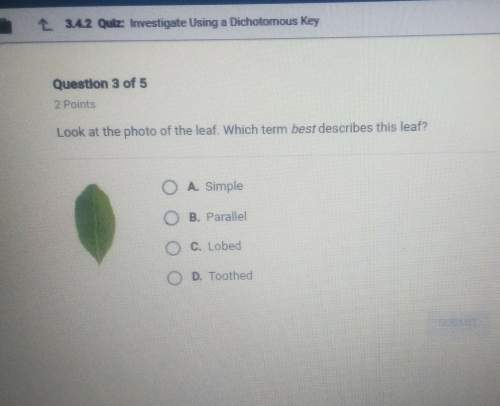
Biology, 13.02.2020 01:29 astultz309459
Chemical germicides a may react irreversibly with proteins/enzymes. b may react with cytoplasmic membranes or viral envelopes. c may be disinfecting or even sterilizing. d are sensitive to dilution factor, time of contact, and temperature of use. e all the above

Answers: 3


Another question on Biology

Biology, 22.06.2019 02:00
Which of the following describes a negative feedback loop? when the heart rate is too high, the body sends hormones that continually increase the heart rate higher. when a pregnant woman is in labor, the body sends hormones that increase the intensity of contractions, which then increases the secretion of the same hormones. when blood sugar is too low, the body sends hormones that raise blood sugar until it reaches a typical level and hormone secretion slows. when a person is jogging, the body sends hormones that continually decrease the rate of oxygen supply to the legs.
Answers: 1

Biology, 22.06.2019 05:30
How is transcription similar to translation in terms of base pairing?
Answers: 3

Biology, 22.06.2019 07:00
The is an estimate of the fewest number of organisms a population needs to avoid extinction. this measurement will most if the number of offspring each female in the population produces increases. if the population's this measurement will most likely increase. 1 population density, minimum viable population, carrying capacity 2 decrease, be unaffected, increase 3 death rate increase, dead rate decrease
Answers: 2

Biology, 22.06.2019 09:00
Hurry i need your (100 points) 1) what are the responsibilities of the region of the brain highlighted below? (picture located below) the highlighted portion is at the rear base of the brain, behind the brain stem. regulating homeostasis, hunger and eating, thirst and drinking, and many other functions of basic survival. coordinating movement and balance by using information from sensory nerves, including hand-eye coordination. controlling voluntary body movements, processing information from sense organs, thoughts, and learning abilities. regulating important involuntary bodily functions such as blood pressure, heart rate, breathing, and swallowing. 2)which of the following systems or structures is correctly paired with its function? neurons - brain cells that control thoughts, calculations, and memory cerebral cortex - portion of the brain that controls involuntary body movement peripheral nervous system - carries impulses to and from the central nervous system central nervous system - carries information from the nerves to the muscles and glands
Answers: 1
You know the right answer?
Chemical germicides a may react irreversibly with proteins/enzymes. b may react with cytoplasmic mem...
Questions


Law, 16.07.2019 23:30

Chemistry, 16.07.2019 23:30

Geography, 16.07.2019 23:30

Social Studies, 16.07.2019 23:30

Biology, 16.07.2019 23:30


Geography, 16.07.2019 23:30


Biology, 16.07.2019 23:30


Biology, 16.07.2019 23:30

Mathematics, 16.07.2019 23:30


Mathematics, 16.07.2019 23:30

Biology, 16.07.2019 23:30

Biology, 16.07.2019 23:30

Mathematics, 16.07.2019 23:30

Computers and Technology, 16.07.2019 23:30

Health, 16.07.2019 23:30




